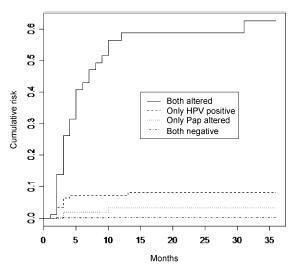Summary
Revista Brasileira de Ginecologia e Obstetrícia. 2016;38(3):147-153
03-01-2016
To compare the predictive capability of HPV and Pap smear tests for screening pre-cancerous lesions of the cervix over a three-year follow-up, in a population of users of the Brazilian National Health System (SUS).
This is a retrospective cohort study of 2,032 women with satisfactory results for Pap smear and HPV tests using second-generation hybrid capture,made in a previous study. We followed them for 36 months with data obtained from medical records, the Cervix Cancer Information System (SISCOLO), and the Mortality Information System (SIM). The outcome was a histological diagnosis of cervical intraepithelial neoplasia grade 2 or more advanced lesions (CIN2ş). We constructed progression curves of the baseline test results for the period, using the Kaplan-Meier method, and estimated sensitivity, specificity, positive and negative predictive value, and positive and negative likelihood ratios for each test.
A total of 1,440 women had at least one test during follow-up. Progression curves of the baseline test results indicated differences in capability to detect CIN2ş (p < 0.001) with significantly greater capability when both tests were abnormal, followed by only a positive HPV test. The HPV test was more sensitive than the Pap smear (88.7% and 73.6%, respectively; p < 0.05) and had a better negative likelihood ratio (0.13 and 0.30, respectively). Specificity and positive likelihood ratio of the tests were similar.
These findings corroborate the importance of HPV test as a primary cervical cancer screening.

Summary
Revista Brasileira de Ginecologia e Obstetrícia. 2003;25(2):81-86
07-04-2003
DOI 10.1590/S0100-72032003000200002
PURPOSE: to describe the frequency of precursor lesions of cervical cancer in 15 to 29-year-old women, associating the degree of damage with the epidemiologic characteristics and associated risk factors. METHODS: a transverse study was performed, where the precursor lesions of cervical cancer were investigated through Papanicolaou test in 15 to 29 year-old women with active sexual life, living in Rio Branco (AC), in the period from January to September 2001. The investigated data included epidemiologic information, risk factors and physical-ginecological examination results, including Schiller test and smears for cytopathologic test. RESULTS: of the 2,397 women studied, 155 (6.4%) showed some kind of cellular epithelial alteration, 146 (94.2%) squamous lesions and 9 (5.8%) glandular lesions. In 15 to 19 year old women, the frequency (6.9%) of cellular epithelial alteration was similar to that observed in 20 to 29-year-old women (p>0.65). These alterations were associated with low educational level (p<0.003), with the number of sexual partners (p<0.04), with STD history (p<0.001) and smoking habits (p<0.01). CONCLUSION: the high frequency of precursor lesions in an age lower than expected, and following an epidemiologic pattern observed in other phases of women's life, shows the early exposure to risk factors, which anticipates the development of cervical cancer.